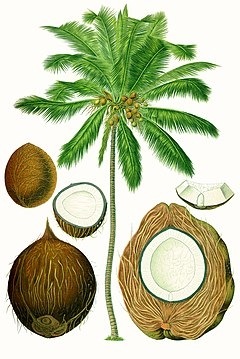
Coconut palm
#history The origin of this plant is very uncertain, and it is disputed whether it is native to the Asian or American tropical coasts. Whatever its origin, today it is distributed along intertropical coasts around the world, and it is likely that its extension was due to the great resistance of its seed, adapted to being disseminated at a great distance by sea currents. It is not unusual to find coconuts that have thus reached coasts far removed from their populations and that still retain their ability to germinate if they are provided with the right conditions.
Etymologies
The name was given to it by Portuguese navigators during Vasco da Gama's first trip to India, who brought coconut to Europe for the first time. According to Losada, the sailors gave it the name because of the similarity between the face that the nut seems to have —two eyes and an open mouth— and the monster coco, coca or cuca in Portuguese folklore, and coco, cuckoo or cucuy in Spanish.[4] [5] Apparently the name “coco” came from the encounters in 1521 between Portuguese sailors and the inhabitants of the Indian coast, because no similar name is found in any of the languages of the area, where the Portuguese found the fruit; in fact Barbosa, Barros and García, when mentioning the name in the languages Tamil-Malayalam and Kannada, called Temga and Narle, respectively. They say clearly, “we call those fruits quoquos”, “our people gave them the name coco” and “the one we call coco and those of Malabar temga”.[citation required
- Comments (4)
- Recommended
- Milestones




Here are your recommended items...
Here are your milestones...




